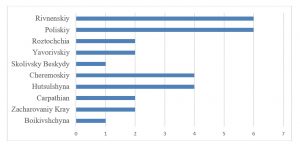PECBMS in Ukraine: First results
September 13, 2023
In 2023, despite the difficult wartime conditions, the first surveys for the Pan-European Common Bird Monitoring Scheme implemented by the Frankfurt Zoological Society (FZS) were done in Ukraine. As the primary method, passive acoustic monitoring was used due to the lack of ornithologists and volunteers on the sites. That became possible only due to the help of WildLife Acoustics, Catalan Ornithological Institute and the Czech Society for Ornithology – as a donation, 16 acoustic recorders SM micro were provided to make surveys on the territory of Ukrainian Polesia and Carpathians.
Common Bird monitoring is essential for understanding global biodiversity changes happening nowadays. It has never been done in Ukraine and will allow us to get annual accurate bird species composition and abundance data. The study of bird species composition and abundance, particularly within protected areas, has significant practical importance for biodiversity conservation in regions representing the best examples of wild nature conservation and allowing monitoring changes in bird populations over time, driven by global negative environmental factors (such as climate change). Implementing the monitoring of common bird species plays a significant role in the European integration of Ukraine besides conservation importance. An extensive country area makes standard surveys difficult due to a lack of experts. However, autonomous recording units (ARU) allow surveys with no ornithologists and bird experts because acoustic monitoring can be done without special ornithological knowledge.
The aim of FZS activity within the collaboration with Nature Preservation Fund Institutions is to establish a Common Bird Monitoring Scheme in Ukraine: develop the methodology applied for national conditions, test it and modify it in accordance if needed, and make surveys using ARU.
As model areas, a few protected areas in Carpathians and Polesia were chosen. In total, 19 recorders were used – 4 SM mini (already provided by FZS to protected areas) and 16 donated SM micro.
The methodology of the introduced monitoring of common bird species in Ukraine was as follows. Surveys were made by PA staff twice a year at the end of April – beginning of May (first survey) and end of May – beginning of June (second survey). ARUs were used on the transect with 5 points (Fig. 1). On each of the points, the survey was done. There will be 5 minutes of recordings on each point. The observer started and stopped the recording after 5 minutes, then moved at least 500 m to the next point and started the recording again. It needn´t be linear, but the surveyor must pay attention not to come closer than 500 m from the nearest point. The points where acoustic data collection took place were recorded using SMART software.

Fig. 1 Scheme of the survey transect with points (min. 500 m apart)
PA staff developed the transects in advance and agreed with the coordinator. They were planned to be easy to access without additional fuel and travel expenses.
In total, eight protected areas in Carpathians and the adjacent regions (National Nature Parks (Boikivshchyna, Zacharovaniy Kray, Carpathian, Hutsulshchyna, Cheremoskiy, Skolivsky Beskydy, Yavorivskiy) and Roztochchia Nature Reserve) and two protected areas in Polesia (Rivnenskiy Nature Reserve and Poliskiy Nature Reserve) took part in surveys. Total number of transects is 30.

Fig. 2 Number of transects in different PAs
Analyses were done manually with the program Raven Lite – ornithologists listened to the recordings and filled the form, partially with Arbimon software. As a result, we got a species list. Done annually, it will allow us to get monitoring data important for understanding species dynamics within protected areas. Preliminary results showed that 40 bird species were recorded, but this data will increase as more data will be analysed.
This initiative represents a significant step for Ukraine in biodiversity conservation and understanding the impact of global changes on the natural environment. Furthermore, it actively supports the efforts of national Nature Preservation Fund institutions and promotes the development of Ukraine’s international environmental research collaborations.
Tatiana Kuzmenko, Yuriy Strus, Hanna Kuzo, Maksym Vysochyn
